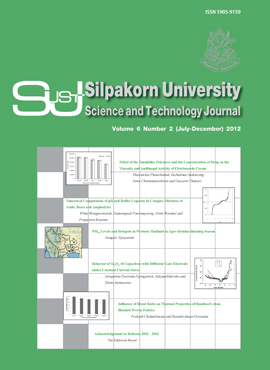Effect of the Emulsifier Polymers and the Concentration of Drug on the Viscosity and Antifungal Activity of Clotrimazole Cream
Main Article Content
Abstract
The preparation of emulsions without heating is an ideal production process for the heat-sensitiveingredients and energy saving. This study investigated the utilization feasibility of emulsifying polymers incream base prepared without heating for clotrimazole. A stable and acceptable cream base readily for mixingwith clotrimazole was prepared at room temperature using isopropyl isostearate as an oil phase, emulsifyingpolymer as an emulsifier, concentrated paraben as a preservative, polyethylene glycol 400 as a solubilizerand distilled water as a water phase at a ratio of 15:3:1:5:75, respectively. Clotrimazole creams comprisingemulsifying polymer were evaluated for their viscosity and pH. The evaluations were also performed on thedrug release using Franz diffusion cells and the inhibition of Candida albicans using agar diffusion methodcompared with a commercial product. The drug loading and the viscosity of cream influenced the drugrelease and the antifungal activity of this developed clotrimazole cream. The types of emulsifying polymeralso affected the drug release but not the antifungal activity. The drug release and antifungal activity of thisclotrimazole cream were not significantly different from Canesten® cream. There was a possibility to prepareclotrimazole cream without heating using the emulsifying polymer.
Downloads
Article Details
References
AHFs Drug information part 5, (2005). American Society of Health-System Pharmacists, Bethesda, USA., pp. 3366-3371.
Ahmed, M. O. and El-Gibaly, I. (1998). Effect of cyclodextrins on the physicochemical properties and antimycotic activity of clotrimazole. International Journal of Pharmaceutics, 171: 111-121.
Anchisi, C., Maccioni, A. M., Sinico, C., and Valenti, D. (2001). Stability studies of new cosmetic formulations with vegetable extracts as functional agents. Il Farmoco, 56: 427-431.
Anna, R. B., Maria, C. B., Giovanni, M., and Franco, F. V. (2006). Development and stability of semisolid preparations based on a supercritical CO2 Arnica extract. Journal of Pharmaceutical and Biomedical Analysis, 41: 449-454.
Burgess, M. A. and Bodey, G. P. (1972) Clotrimazole : in vitro and clinical pharmacological studies. Antimicrobial Agents and Chemotherapy 2: 423-426.
Chang, J. Y., Oh, Y., Kong, H. S., Kim, E. J., Jangd, D. D., Namd, K. T., and Kima, C. (2002). Prolonged antifungal effects of clotrimazole containing mucoadhesive thermosensitive gels on vaginitis. Journal of Controlled Release, 82: 39-50.
Chowdary, K. and Kumar, P. A. (1994). Formulation and evaluation of topical drug delivery systems of ciprofloxacin. Indian Journal of Pharmaceutical Sciences, 58(2): 47-50.
Claude, D. and Daniele, C. (1995). Use in cosmetics or in topical application of an aqueous dispersion based on organopolysiloxanes and on a cross-linked acrylamide/neutralized 2-acrylamido-2-methylpropanesulfonic acid copolymer. U.S. Patent No. 5470551.
Cohn, M. S. (1992). Superficial fungal infections. Topical and oral treatment of common types. Postgraduate Medicine, 91: 239-244, 249-252.
Gupta, A. and Tu, L. (2006). Dermatophytes: diagnosis and treatment. Journal of the American Academy of Dermatology, 54: 1050-1055.
Higuchi, W. I. (1962). Analysis of data on the medicament release from ointments. Journal of Pharmaceutical Sciences, 51: 802-804.
Janet, C., Kevin, M., Laura, F., Rita, B., and Edward, J. B. (1986). Clotrimazole treatment for prevention of oral candidiasis in patients with acute leukemia undergoing chemotherapy: Results of a double-blind study. The American Journal of Medicine, 81(5): 771-774.
Juntawong, S., Charoenteeraboon, J., Chansiri, G., and Phaechamud, G. (2009). Utilization feasibility of emulsifying polymers in cream base. Thai Pharmaceutical and Health Science Journal, 4(4): 456-462.
Kim, H. and Fassihi, R. (1997). Application of binary polymer systems in drug release rate modulation. 2. Influence of formulation variables and hydrodynamic conditions on release kinetics. Journal of Pharmaceutical Sciences, 86: 323-328.
Lindner, W. D. and Lippold, B. C. (1995). Drug release from hydrocolloid embeddings with high or low susceptibility to hydrodynamic stress. Pharmaeutical Research, 12: 1781-1785.
Lorian, V. (1991). Antibiotics in Laboratory Medicine. Williams and Wilkins, Baltimore, pp. 12-13.
Mehling, A., Kleber, M., and Henson, H. (2007). Comparative studies on the ocular and dermal irritation potential of surfactants. Food and Chemical Toxicology, 45(5): 747-758.
Pandey, R., Ahmad, Z., Sharma, S., and Khuller, G. K. (2005). Nano-encapsulation of azole antifungals: Potential applications to improve oral drug delivery. International Journal of Pharmaceutics, 301(1-2): 268-276.
Reynolds, T. D., Gehrke, S. H., Hussain, A. S., and Shenouda, L. S. (1998). Polymer erosion and drug release characterization of hydroxypropyl methylcellulose matrices. Journal of Pharmaceutical Sciences, 87: 1115-1123.
Ritter, W., Patzschke, K., Krause, U., and Stettendorf, S. (1982). Pharmacokinetic fundamentals of vaginal treatment with clotrimazole. Chemotherapy, 28: 37-42.
Salomon, J., Doelker, E., and Buri, P. (1979). Importance de la technologie formulation mecharnism liberation potassium content matrices hydrophiles. Influence of viscosity of percentage of gel. Acta Pharmaceutica Helvetiae, 54: 82-85.
Shadomy, S. (1971). In vitro antifungal activity of clotrimazole. Infection and Immunity, 4(2): 143-148.
Shantha, K. L. and Harding, D. K. (2003). Synthesis, characterisation and evaluation of poly [lactose acrylate-N-vinyl-2-pyrrolidinone] hydrogels for drug delivery. European Polymer Journal, 39: 63-68.
Souto, E. B., Wissing, S. A., Barbosa, C. M., and Muller, R. H. (2004). Development of a controlled release formulation based on SLN and NLC for topical clotrimazole delivery. International Journal of Pharmaceutics, 278: 71-77.
Tehrani, M. R. and Mehramizi, A. (2000). In vitro release studies of piroxicam from oil in water creams and hydroalcoholic gel topical formulations. Drug Development Industrial Pharmacy, 26(4): 409-414.
Thais, G. and Mirela, D. (2006). Stability of cosmetic formulations containing esters of Vitamins E and A: Chemical and physical aspects. International Journal of Pharmaceutics, 327: 12-16.
Vlachou, M. D., Rekkas, D. M., Dallas, P. P., and Choulis, N. H. (1992). Development and in vitro evaluation of griseofulvin gels using Franz diffusion cells. International Journal of Pharmaceutics, 82(1-2): 47-52.
Yan-Fei, L., Ke-Long, H., Dong-Ming, P., Ping, D., and Gui-Yin, L. (2007). Preparation and characterization of glutaraldehyde cross-linked O-carboxymethyl chitosan microspheres for controlled delivery of pazufloxacin mesilate. International Journal of Biological Macromolecules, 41(1): 87-93.
Zeljka, P., Natasa, S. B., and Ivan, A. (2005). Characterisation and in vitro evaluation of bioadhesive liposome gels for local therapy of vaginitis. International Journal of Pharmaceutics, 301: 140-148.


